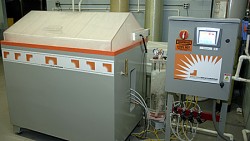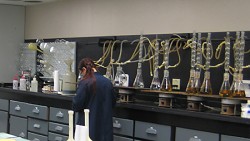CORROSION TESTING
STANDING UP TO ENVIRONMENTAL CONDITIONS
Corrosion Testing determines the resistance of materials to corrosion under certain environmental conditions, including temperature, humidity and salt water. Laboratory Testing Inc. offers a full array of corrosion testing services at our Philadelphia, PA (USA) area facility to ensure the performance of metals, platings and coatings.
A wide-range of ASTM Corrosion Testing is provided, including the ASTM B117 Salt Spray Test. Many additional corrosion testing services are available and performed to industry specifications.
 |
CORROSION TESTING |
Our Corrosion Testing capabilities are enhanced with an SEM/EDS system for detailed analysis and identification.
CORROSION TESTING METHODS AT LTI
LTI’s corrosion specialists perform Salt Spray Testing, Humidity Testing and many additional corrosion test services according to industry standards:
- Susceptibility to Intergranular Attack in Austenitic Stainless Steels (ASTM A262 Practice A, B, C, E, F)
- Detrimental Intermetallic Phase in Duplex Austenitic/Ferritic Stainless Steels (ASTM A923 Method C)
- Aluminum Exfoliation Test (ASTM G34)
- Pitting and Crevice Corrosion Resistance of Stainless Steels and Related Alloys (ASTM G48 Methods A, B, C, D, E, F)
- Visual Assessment of Exfoliation Corrosion Susceptibility of 5XXX Series Aluminum Alloys (ASSET Test) (ASTM G66-99(2005)e1)
- Susceptibility to Intergranular Corrosion in Wrought, Nickel-Rich, Chromium-Bearing Alloys (ASTM G28 Methods A, B)
- Susceptibility to Intergranular Corrosion of 5XXX Series Aluminum Alloys by Mass Loss After Exposure to Nitric Acid (NAMLT Test) (ASTM G67-04)
- Humidity Test (AMS 2700)
- Passivation Test (ASTM A380, ASTM A967 & MIL-STD 753 Methods 102, 103)
- Salt Spray Test / Salt Fog (ASTM B117 Testing, MIL-STD-202, MIL-STD-810, NASM-1312-1)
- Coating Evaluation (Adhesion, Thickness)
- Hydrogen Embrittlement
- Intergranular Oxidation
- Post Exposure Evaluation
- Sensitization
- Sigma Chi Phase
 |
| Salt spray testing |
** Find out the sample size needed for testing before sending your material.
SEM/EDS Analysis
An SEM/EDS system at Laboratory Testing provides extensive corrosion testing capabilities. The system is particularly helpful in microanalysis with its high resolution imaging capabilities to a magnification of 300,000x for analyzing small areas of interest on samples. The SEM/EDS is also used for analysis of corrosion deposits to identify the corrosive agent.
VALUABLE INFORMATION FOR PRODUCT DEVELOPMENT THROUGH END USE
Since all metals and alloys are susceptible to corrosion, corrosion test results can help businesses make sound decisions. The effects of corrosion can be costly and devastating, so it generally makes sense to perform testing before damage occurs, often during product design. Corrosion testing is an important step in material selection in order to establish the suitability of materials for their intended use. Corrosion analysis can also help identify a corrodent or an environmental cause, if an unexpected corrosion problem occurs.
 |
| Corrosion Testing |
LTI offers testing to provide answers for all your corrosion needs:
- Comparing and selecting appropriate materials
- Evaluating protective treatments
- Estimating the life of products
- Determining if material will meet its intended application
- Identifying corrodents and environmental factors responsible for corrosion attack
- Establishing the root cause of a product failure
TEST METHODS/SPECIFICATIONS
- AMS 2700
- ASTM A262 Practice A, B, C, E, F **
- ASTM A380
- ASTM A923 Methods A, C **
- ASTM A967
- ASTM B117
- ASTM G1
- ASTM G28 Methods A, B
- ASTM G34
- ASTM G48 Methods A, B, C, D, E, F **
- ASTM G66-99(2005)e1
- ASTM G67-04
- MIL-STD 753 Methods 102, 103
ABOUT TEST PROCESSES
Salt Spray Test
Our ASTM B117 Salt Spray Test, also known as Salt Fog Test, is performed according to stringent procedures. This includes testing of a material in a controlled corrosive environment which has been used to produce relative corrosion resistance information for specimens of metals and coated metals. At LTI, the test is run in a salt spray chamber with precision temperature control.
Temperature and Humidity Testing
Our environmental chamber is ideal for ensuring the reliability of products such as electronic items through exposure to thermal cycling, fast temperature cycling, and extreme temperature and humidity conditions. Temperature Testing is available in the range of -94°F to +356°F (-70°C to +180°C). Humidity Testing is in the range of 10% to 95% relative humidity and simulates a damp environment. The temperature and humidity working ranges comply with DIN, ISO, MIL, IEC, DEF and ASTM testing standards.
Passivation Test
Passivation Testing evaluates the surface of corrosion-resistant steel parts by looking at surface passivity. The passivation process can remove surface contamination that can lead to rust, such as iron particles and exposed sulfides, to maximize the natural corrosion resistance of stainless steel. Upon testing, material that has been properly passivated will be virtually free of rust. The passivation test may also be useful in determining if there is a need for a treatment or protective coating on fabricated steel parts.

Comments
Post a Comment